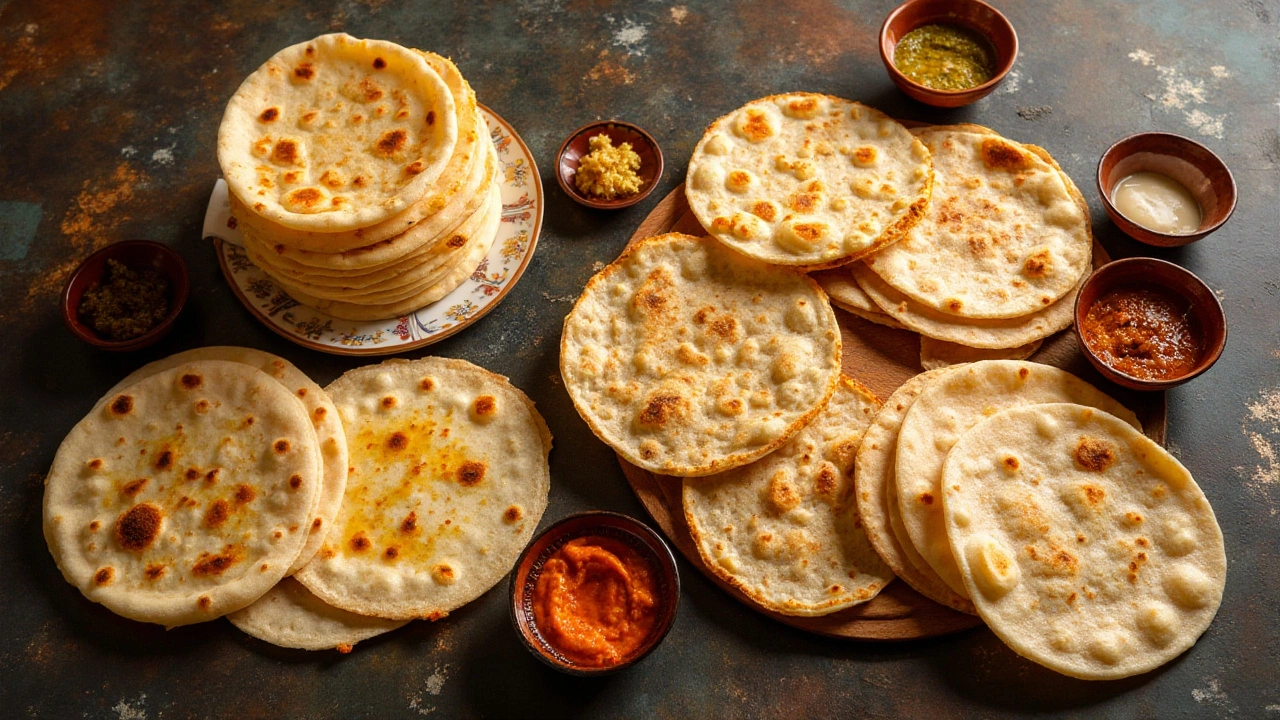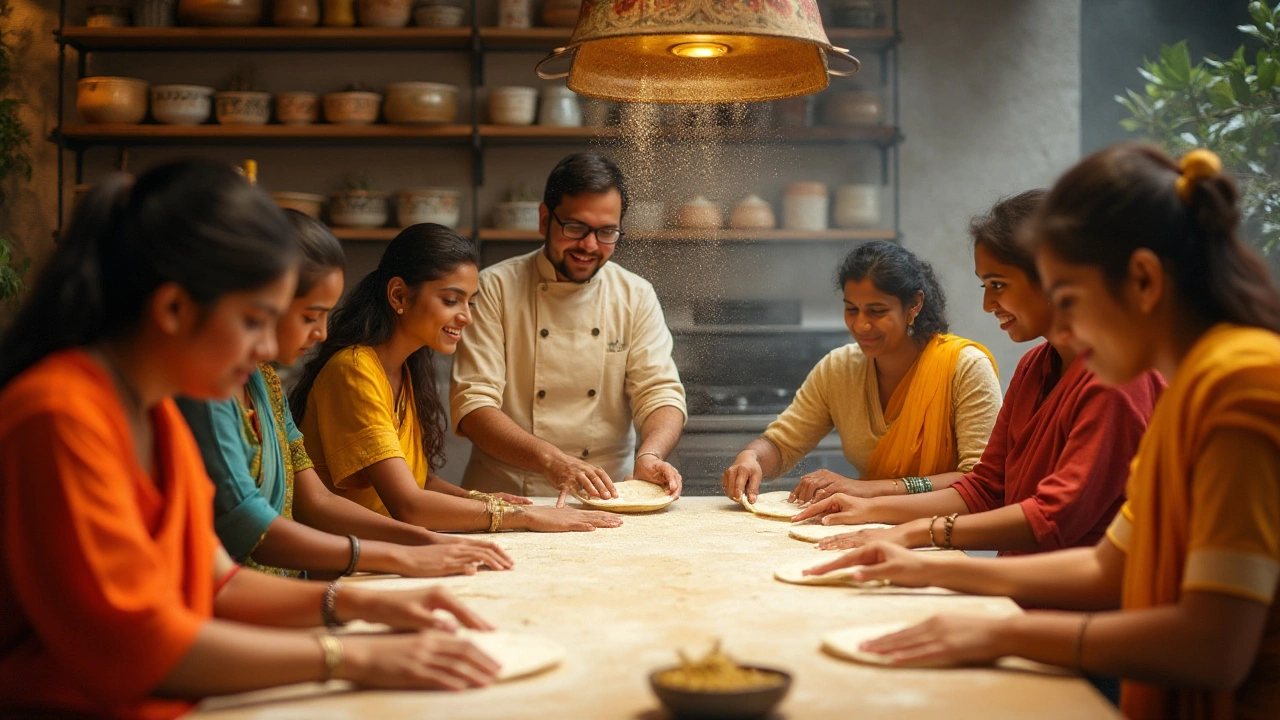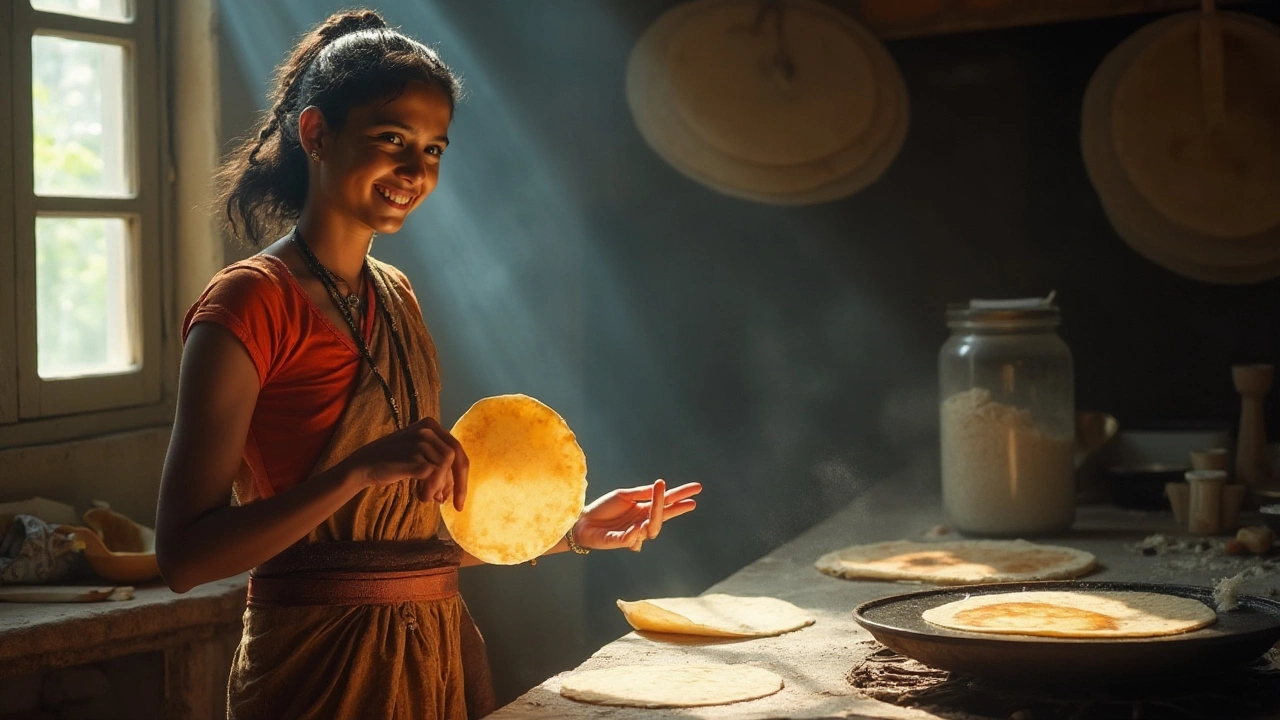Roti—it's more than just bread. It’s a tradition, a staple, and a delicious slice of culture that graces tables across the globe. But a question often arises among both novice cooks and seasoned chefs: should roti be thick or thin? With robust debates in many kitchens, the thickness of roti doesn't just alter its appearance but significantly impacts its taste and texture, playing a vital role in the overall eating experience.
In this culinary journey, we'll dive into the fascinating world of roti making, exploring why some prefer their roti on the dense side while others enjoy it light and crisp. There’s no definitive answer—it truly boils down to preference and purpose. Through understanding the nuances of both styles, you'll be equipped with the knowledge to recreate your perfect roti, whatever that may mean for you.
- Understanding Roti and Its Origins
- The Charm of Thick Roti
- The Delicacy of Thin Roti
- Factors Affecting Roti Thickness
- Tips for Mastering Your Preferred Roti Style
Understanding Roti and Its Origins
Roti holds a cherished place in the culinary tapestry of South Asia, often regarded as the heartbeat of Indian kitchens. This unleavened flatbread, made primarily from whole wheat flour, roti making, involves an intricate blend of skill and intuition, often passed down through generations. The word 'roti' itself is rooted in the Indian subcontinent, where its preparation and consumption date back thousands of years, echoing through the alleys of history with each roll of dough.
The preparation of roti can vary remarkably depending on regional customs and personal family traditions. While in the northern parts of India, roti is often associated with a softer, more pliable texture, meant to accompany dishes rich in gravies, other regions might prefer a firmer consistency, allowing it to be more easily stored and transported. Across borders, similar counterparts exist under different names—'chapati’ in some areas, ‘phulka’ in others, and even as far as Trinidad, where it's a staple part of the local cuisine due to the Indian diaspora. Each version brings its own flair, connecting communities through the shared simplicity and deliciousness of this ancient bread.
There's a saying in many cultures where roti is revered, that a perfect piece is a reflection of one's soul. Such is its importance in daily life that making it well is often considered an art form. The debate of thick roti versus thin roti is a topic that ignites passion, not only for taste but for its cultural significance. As renowned artist from India states, "Roti is not just food; it is a bridge to our heritage and a canvas for our daily creativity."
Today, roti continues to evolve with modern interpretations, finding its place not only in traditional meals but also in global fusion dishes where chefs experiment with diverse fillings and flavors. Yet, at its heart, it remains a simple, wholesome bread that nourishes both body and soul, a humble dish bound by tradition yet open to innovation.
The Charm of Thick Roti
Thick roti carries with it a certain allure that resonates with many, especially those in regions where hearty foods are a beloved tradition. One can't help but appreciate the rustic appeal and the substantial bite that a thick roti offers. This type of roti, often slightly chewy and robust, becomes a canvas for flavors and textures, serving as an excellent companion to rich, spicy curries or simple, buttery accompaniments. The thickness provides an enjoyable mouthfeel that contrasts beautifully with the dishes it is paired with, often absorbing the gravies and sauces in a unique dance of textures.
Cultural influences significantly impact the preference for thicker roti. In several parts of Pakistan and northern India, thicker variations are favored, known locally as 'paratha' or 'naan'. These thicker breads are not just a vehicle for delivering food to the mouth but are cleverly engineered sponges that soak up the essence of the main dish, enhancing the overall dining experience. Some believe that a thicker roti brings a certain warmth and comfort, a feeling echoed in dishes meant to be hearty and sustaining.
"The thicker the bread, the more satisfying it is to consume," notes culinary historian Julius Lacend, emphasizing the substantial nature of traditional thick rotis.
The creation of a thick roti requires a careful balance of flour, water, and oil, typically worked into a velvety dough. The thickness follows the method of preparation; when rolled only to a certain extent, the dough retains a certain puffiness that, when cooked, produces a satisfying, chewy texture. The process of making thick roti also has its own rhythm and ritual; it’s often enjoyed in the making as much as consuming. The artful tossing to maintain even thickness and the tactile experience of rolling can become a comforting ritual that connects cooks to a lineage of past generations.
For those keen on trying their hand at making thick roti, it’s worth noting that the type of flour—often whole wheat or 'atta'—can heavily influence the outcome. Some chefs even experiment with multigrain mixes to add nuttiness and nutritional value, enhancing the wholesome sense that thick roti already evokes. Additionally, cooking techniques vary; some prefer using a conventional tawa, which can impart a slight smokiness, while others lean towards baking, allowing the roti to puff nicely while maintaining its hefty texture.
Benefits of Thick Roti
- Hearty and Filling: Thick roti provides a more robust eating experience, suitable for those needing more sustenance in their meal.
- Flavor Absorption: Its density and surface area make it ideal for soaking up sauces and gravies, enhancing the meal's taste.
- Texture Variety: Provides a contrast to soft, creamy dishes, adding an enjoyable chewiness.
- Cultural Tradition: Often tied to traditional dishes and family recipes, offering a taste of cultural heritage.
- Experimentation: Allows for innovative adaptations with different flours and preparation methods.
The thick roti continues to be a symbol of rich culinary heritage. Its satisfying nature and cultural significance create a delightful dining experience, cementing its place in the annals of traditional cooking. Whether you prefer your roti with a side of curry or a bit of ghee, the charm of thick roti is unmistakable, offering sustenance with every bite.

The Delicacy of Thin Roti
Thin roti, often celebrated for its versatility and lightness, brings its own unique charm to the dining table. The art of crafting a delicate, papery roti lies in the precision of rolling and cooking. Each paper-thin piece is a testament to skill, where the tender layers flake apart almost effortlessly. Such roti is particularly favored in regions where it's used as a wrap or served alongside rich and flavorful curries, providing a perfect balance that doesn’t overwhelm the palate with doughy texture.
Achieving the perfect thin roti requires attention to the elasticity of the dough. Typically, the dough needs to rest suitably before rolling to allow the gluten to relax, which makes the dough more pliable. A common rule of thumb is to let it rest for at least 15 to 30 minutes. Once rested, using barely dusted surfaces and rolling pins minimizes additional flour incorporation, aiding the rolling process. As the roti making technique is refined, one quickly learns that evenly rolling from the center outward ensures a uniform thickness, crucial for even cooking.
Cooking thin roti to perfection is about timing and heat. A hot, flat tawa, or skillet, is ideal, with rapid flipping allowing each side to crisp briefly without burning. The thin nature means it can cook within seconds, so vigilance is key. This is not only about flavor; tradition plays a role too. In many cultures, thin roti embodies hospitality, as its creation demands patience and skill, often passed through generations. A well-known chef once said, "Roti is not just a bread; it is an expression of warmth, delicately uniting the heart and hand in its making."
For daily meals or special occasions, thin roti is a beloved choice. It's prized for its ability to mop up sauces while staying light in texture. When done right, it adds an elegant touch to the meal. According to a survey, 60% of households in Northern India prefer thin roti over its thicker counterpart for its multiplicity of pairing options. Beyond its culinary role, making thin roti can be a family affair, fostering bonds as recipes and techniques are shared from parents to children, each family adding its unique twist to this classic staple.
Factors Affecting Roti Thickness
When it comes to crafting the perfect roti, thickness is undoubtedly a crucial factor that significantly influences its texture and flavor. A multitude of aspects can determine whether a roti turns out thick and robust or thin and delicate. Understanding these elements can help anyone, from a novice to an experienced cook, to create rotis that best suit their preferences and intended culinary applications. One primary factor is the flour used. Atta, a type of whole wheat flour, is the traditional choice for roti making due to its unique gluten content, which provides elasticity. The type and quality of flour can alter the dough's ability to rise and stretch, affecting whether the roti results in a thicker or thinner bread. High-quality atta flour often results in a more pliable dough, potentially leading to thinner rotis, if that's the aim.
Another significant aspect is the hydration level of the dough. The water content affects how the dough behaves during rolling and cooking. A dough with higher hydration tends to spread more easily, allowing for thinner rotis. Conversely, a drier dough might result in thicker rotis due to its less flexible consistency. The skill and frequency of kneading also play a role. Properly kneaded dough becomes more elastic, allowing it to be rolled thinner. In contrast, insufficiently kneaded dough might be resistant to thinning, creating thicker outcomes that some people prefer for their chewiness.
The rolling technique greatly influences whether a roti turns out thick or thin. Here, practice proves essential. A light hand that moves swiftly from the center to the edges can help achieve a thinner, more even roti. Alternatively, applying more pressure or using a particular rolling technique might make the rotis thicker. Some cooks rely on their grandmother's advice when rolling, ensuring they press just right to reach the desired consistency. Cooking time and temperature are crucial factors, too. Rotis cooked over high heat for shorter periods tend to puff up and might be thinner as they don't dry out. Meanwhile, lower heat can result in a thicker texture as the moisture has more time to evaporate before the dough cooks through. As a well-known roti expert once shared, "The art of roti is in the control of heat—it determines everything." The addition of ghee or oil, whether during rolling or cooking, contributes an extra layer of complexity. Adding fat creates an exceptional mouthfeel and can affect thickness, with more fat often resulting in slightly thicker, richer rotis that some find irresistible.
Additional ingredients such as spices or grains can also impact thickness. For instance, adding grains might make the dough tougher to work with, thus conducive to thicker rotis. Spicing not only changes flavor but might also slightly alter texture, influencing how the roti rolls out. Among various practices, traditions of a household also play an important role. Quite often, family preferences and locale-specific customs guide how roti is prepared. Some regions thrive on thicker varieties, deeming them soul-satisfying. Others lean towards a more flattened, almost paperlike form as a cultural hallmark. Environmental conditions, particularly humidity and altitude where the cooking is happening, can't be ignored either. Such natural factors subtly interact with dough, nudging the thickness needle.
Roti tips also extend to using utensils. The type of rolling pin, surface, and even griddle, or tawa, can influence outcomes. Significantly, embracing these subtle adjustments aids in achieving desired results. Factors converge, departing from formulaic recipes, to offer individually tailored rotis. Experiment and learn from each delicious endeavor. After all, mastering roti making is not a destination, but a journey replete with delightful flavors and textures.

Tips for Mastering Your Preferred Roti Style
Crafting the perfect roti involves a blend of technique, intuition, and a dash of personal flair. To begin with, understanding the intention behind your roti’s thickness can guide you in finding the right balance. Do you crave a chewy companion for your spicy curries, or are you seeking that paper-thin, almost ephemeral experience for a more subtle dish? Whichever your preference, getting the dough right is paramount. The dough acts as the foundation. For a thick roti, aim for a softer dough, often achieved by adding a bit more water than usual, allowing the elasticity to endure the rolling process. But be cautious - too much can lead to stickiness, complicating your rolling efforts. A thicker dough should be smooth yet pliant.
For those pursuing a thin roti, the approach alters slightly. Here, a slightly firmer dough is key, so it can withstand being rolled out extensively without tearing. This involves a delicate balance of the right amount of water and kneading. A trick often shared among experienced cooks is to let the dough rest. Allow it to sit for at least 20 minutes covered with a damp cloth. This resting phase helps develop gluten, making the dough more manageable whether you are aiming for a thick or thin finish.
‘A well-rested dough is like a good night’s sleep for a person – it makes the world of difference,’ as acclaimed chef Zara Khan once observed.
The Art of Rolling
Next, comes the rolling stage. Here is where the magic truly happens. For a thick roti, roll gently. It’s less about intense pressure and more about evenly distributing it across the dough’s surface. Consider it as caressing the dough into shape rather than forcing it. A circular motion works best, starting from the center and gradually moving outward. Flip the dough occasionally to ensure even thickness and prevent sticking to the rolling surface.
Why Heat Matters
Let’s not overlook the role heat plays in your roti-making journey. Whether thick or thin, ensuring your cooking surface is adequately hot is critical. It’s generally recommended that, for thin roti, the pan is on the higher end of medium heat. This ensures quick cooking and helps achieve those coveted brown spots which add not only texture but flavor complexity. For thicker roti, moderate the heat a bit allowing the inside to cook through without burning the exterior.
| Roti Type | Recommended Dough Hydration | Cooking Heat Level |
|---|---|---|
| Thick Roti | Higher Hydration (Softer Dough) | Medium Heat |
| Thin Roti | Lower Hydration (Firmer Dough) | Medium-High Heat |
Keep experimenting with the heat and adjust depending on your kitchen environment and the nature of your stove. An essential tip is to always preheat the pan or tawa; it should be hot enough so that a few droplets of water sprinkled on it sizzle and evaporate instantly. This ensures the roti puffs up properly and attains the desired texture.
Finally, don’t shy away from using trial and error to perfect your technique. Roti making, like any culinary skill, is a journey. Whether you're calling on ancestral wisdom or picking up modern twists, each small adjustment leads you one step closer to your own roti perfection. Embrace the experimentation, and don't hesitate to blend traditional methods with your personal touch to create something truly yours.
